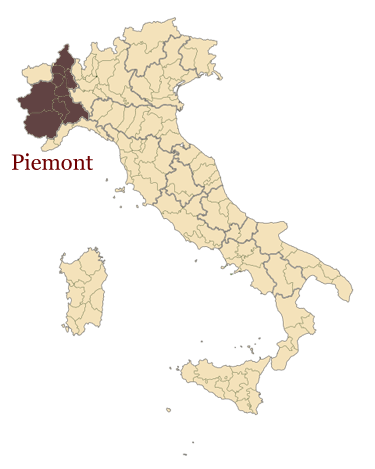
Piedmont

Piedmont, meaning the "foot of the mountains" (Alps) is situated in North-Western Italy near Turin. The capital city of this region is Asti. Next to Tuscany, this region is the largest wine region in Italy; Tuscany being its only worthy rival. Tuscany is the second Italian region (after Chianti) with regard to production yield, the largest producer of sparkling wines, and the second largest in the world (after Champagne). Piedmont wine production is concentrated in three areas: Monferato (around Asti), Alessandria (around Alba) and Langhe. As in Burgundy, small vineyards prevail.
There are 7 DOCG wine production zones in Piedmont: Asti and Moscato d’Asti, Brachetto d’Acqui, Barbaresco, Barolo, Gattinara, Gavi or Cortese di avi, Ghemme, and 45 DOC wine zones.
The nature of Piedmont wines and food is comparable to the ones from Burgundy. In both regions they are hearty, rich, mature and... inseparable. Piedmont has its own microclimate, characterised by a hot season during grape growth and maturing, which is followed by a foggy autumn and a frequently foggy, cold winter.
Major Piedmont appellations are:
1) Barolo (approx. 1200 ha) with villages-boroughs of La Morra, Serralunga d’Alba, Montforte d’Alba, Barolo and Castiglione Faletto.
2) Barbaresco with communes of Neive, Barbaresco and Treiso.
And: Barbera d’Alba, Barbera d’Asti, Dolcetto d’Alba, Dolcetto d’Asti, Langhe, Moscato d’Asti (known for the production of sparkling wines). Major Piedmont red wine varieties are: Nebbiolo, Barbera and Dolcetto. Moreover, we can find Grignolino, Freisa, Favorita and Cabernet Sauvignon. White varieties are: Muscat (Moscato), Arneis, Cortese di Gavi, Erbaluce di Caluso, and Chardonnay and Sauvignon Blanc. Names of Piedmont wines take source from geographical names (Barolo, Barbaresco – villages, Langhe – hills) or from names of grapes (Barbera, Dolcetto); finally they are often named with the added name of the district (d’Asti, d’Alba).
Nebbiolo is the finest red grape variety producing warm, tasty, hearty and multi-dimensional wines. Barbera is the most important variety producing wines with a similar character as Nebbiolo with a slight plum aroma. Dolcetto are much gentler than Barbera or Nebbiolo, more balanced, resilient and fruity with a hint of bitterness, with a fairly short ageing potential. Grignolino are slightly spicy wines, perfect for quick consumption.
Character of wines: Barolo – hard, tannic and raw, at the same time one of the tastiest wines in the world with a large ageing potential (8-25 years). Barbaresco frequently better balanced and lighter than Barolo, with a similar flavour and aroma, yet with more fruity notes with hints of cedar and chocolate. Similarly high ageing potential (8-25 years). Dolcetto, contrary to its name, are dry, fruity wines with a taste of almonds, chocolate and allspice. Finally, Barbera wines with a strong fruity note, very mature with high acidity, yet very well balanced. It is interesting that still in the 19th century, Nebbiolo in Piedmont was the basis for creating sweet wines, only from the middle of the century one of the French enologists taught the local winemakers to finish the fermentation process in order to obtain massive, dry wines from late harvest, aged any length of time in big oak tanks.
GIANFRANCO ALESSANDRIA
Gianfranco Alessandria is a small family vineyard which was taken over by daughters after the death of their father, ensuring the continuation of tradition started two generations back. The vineyard is located in Monforte d’Alba, near Barolo. With time, it attracted the attention of wine lovers and allowed them to discover the history and taste of local food and wine.
In 1989 the vineyard covered the area of 4 hectares and produced white wines mainly for the local market. Currently, it covers 5.5 hectares and additional 1.5 hectares of land is leased. It gradually underwent modernisation, machines required for modern wine production were purchased; the current yield is 45 thousand bottles per year. All vineyards lie on the south-western side, which allows to produce strong structured, elegant and long-lasting wines.
Owners practice natural production principles. They apply ecological cultivation methods, using the smallest possible amount of chemical fertilisers this way expressing their concern for environmental protection and consumer health.
From the very beginning, the vineyard has been gradually reducing grape yield per hectare to make a more healthy and resistant fruit, finally allowing to obtain higher quality of wine.
The following grape varieties are grown here: Dolcetto, Barbera and Nebbiolo.

